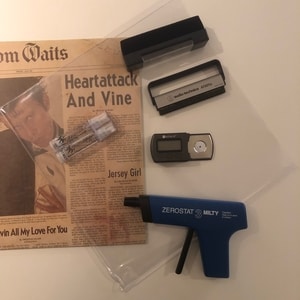
You don’t need to go overboard with fancy accessories to enjoy vinyl records fully. But there are a few items that are more or less must haves for vinyl spinners at every level.
Vinyl records are costly and valuable items. It is crucial to take good care of them. So that they last long and sound great. And to do that, we’ll need a few basic items.
To this day, there are only 7 items that I use regularly for my vinyl collecting and spinning. In this article, I will guide you through these 7 items.
The 7 must have vinyl accessories are:
1. Anti-static brush for dry cleaning
2. Velvet brush for wet cleaning
3. Vinyl record outer sleeves
4. Vinyl record inner sleeves
5. Stylus tracking force gauge
5. Anti-static device
7. Box or shelf for correct vinyl storage
When I got back into the vinyl format again, I skipped most of these.
Or actually, all of them.
Not a clever move.
Because of this, many of my album covers have deteriorated a lot and look worn. And my records often sounded quite bad in the beginning.
But I have learned my lessons now, and in this post I will try to explain why these seven items are must haves for both new and seasoned vinyl spinners and collector.
Let’s go.
1. Anti-static brush for dry cleaning
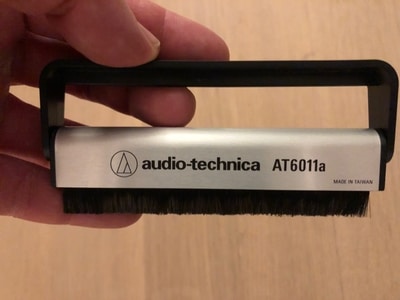
An anti-static brush for dry cleaning is essential for keeping your records free from dust. Dusty records sound noisy. Pops and cracks from dusty records can drive you mad.
The stylus that reads the grooves in the records is very sensitive and transforms even the smallest dust particle it runs into on its way through the grooves into an unwanted sound in the speakers. Keeping your records free from dust is essential for good sound.
Records get dusty quickly. So every time I put a record on the platter to play it, I first give it a quick clean with the anti-static brush to remove all the dust. I start the motor and gently hold the brush against the record, letting it clean itself as it spins around. As the record is spinning, I slowly move the brush from the outer grooves towards the inner grooves so that I cover the whole record. The whole process takes about 30 seconds or so.
If you do this every time you put a record on the turntable to play it, your vinyl music listening experience will be much better.
Click here for a good and inexpensive brush from Audio-Technica that you can buy from Amazon. The one I use myself.
2. Velvet brush for wet cleaning
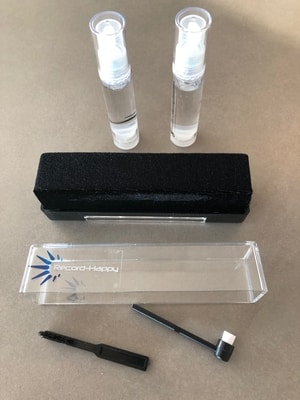
Records collects dirt, grease and fingerprints over time. It is more or less inevitable. The super sensitive stylus on our turntables will pick this up with no problems as it reads the grooves. Just as it does with dust particles. And generate a lot of pops, clicks and crackles in the speakers.
Cleaning the record with a velvet brush and a solution fluid will remove dirt and grease from your record gently and effective. It is not necessary to use this every time you play a record, but from time to time when the record is visually dirty or when the record sound bad even after a dry cleaning.
It is highly recommended to use a dedicated cleaning solution fluid to clean vinyl records. Common household soaps can leave debris in the grooves and make things worse. And alcohol can deteriorate the grooves. A vinyl cleaning solution fluid is the way to go.
A velvet brush for wet cleaning together with an anti-static brush for dry cleaning as discussed above will take care of 99.99% of your record cleaning needs and make your records sound wonderful.
Click here for a good velvet brush with solution fluid that you can buy from Amazon.
3. Vinyl record outer sleeves
LP covers are made of cardboard that will get worn quickly if they aren’t protected with polypropylene outer sleeves. And risking destroying that precious album art work that many artists poured their heart and soul into is just a no-no.
Vinyl record outer sleeves will protect your albums from dust, scratches, or any kind of blemish that might ruin their condition. It is a cheaply bought insurance that will make your albums last for years and years in mint condition.
In my first year of collecting, records I did not use outer sleeves. I even said no thanks when the guy or girl in the record shop offered them for free when I purchased new records. Very clever! And after pulling these records in and out from the collection just a few times the cover edges look worn.
But I have learned my lesson now. It is absolutely no reason to no protect the albums with polypropylene outer sleeves.
Click here for good outer sleeves that are praised by DJs and vinyl collectors.
4. Vinyl record inner sleeves
To further protect the records from dust, static electricity and scuffing, it is highly recommended to use good quality inner sleeves for extra protection as well.
They are inexpensive to buy and will do wonders for storing and preserving records both short and long term.
Click here for popular inner sleeves from Amazon.
5. Stylus tracking force gauge
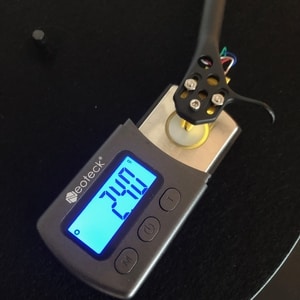
The stylus or needle that read the record grooves is designed to do that job with a very specific downforce or weight. Usually called tracking force. This is around 2.0 grams for most cartridges but varies a bit from type to type so it is important to read the manual for your turntable/cartridge.
If the tracking force is too high or too low, the record will not sound right and the wear and tear on the record and stylus can become significant.
The recommended way to make sure that the tracking force is exactly right is to use a stylus gauge. It is another inexpensive item that can make a big difference.
You don’t have to use this often. Use it when you set up the turntable. From there, check the tracking force once a year or so to make sure it stays in the right spot.
Here is the one that seems to be the most popular. That I use myself. You guessed it. The link is to Amazon.
6. Anti-static device
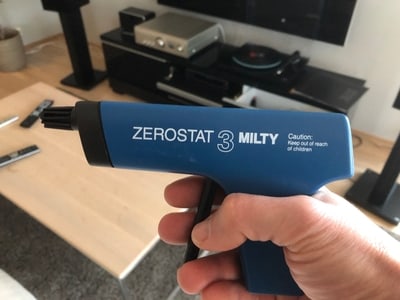
I have already said that the sound of dusty records can drive you mad. Unfortunately, the sound of static records can be even worse.
This one only applies if you live in an area with cold and dry winters. Where you need to use heaters inside to stay warm during the winter and keep doors and windows mostly shut.
This is an ideal environment for static electricity (Wikipedia). If you live in an area like this, you are probably aware of the static electricity that builds up in furniture, sheets, clothes and what have you during the winter. And worst of all, in your vinyl records.
Static electricity builds up in these conditions because there is not enough humidity in the air to discharge the electricity.
Highly static records sound bad for two reasons. Firstly, the cartridge picks up the static electricity directly, and creates noise and crackles in the speakers. Secondly, static records collect even more dust, dirt and particles. Which is also picked up by the stylus/cartridge and create noise, pops and crackles in the speakers.
The solution to this problem is the Milty Anti-Static Device (Amazon link).
It works by first spraying positive ions, then negative ions, leaving the surface of the record with a net zero charge. It is amazing!
To use it, hold the record at the edge with one hand (ideally) or place on the turntable and with a VERY SLOW push and release of the handle, spray the record 4 times on each side. On spray for every “quadrant” on the record. It is important to push and release the handle super slow. If done too fast, it won’t work.
NB! The cap at the tip of the device is a cover and most be removed when using it.
Check out this YouTube video that shows how this is done.
There was a time in the 2018/2019 winter that I almost gave up on vinyl records because of major issues with static electricity. Then I bought this device, and the problem was significantly reduced. I could enjoy my vinyl records again. So this tool is a must have if you live in an area where static electricity can be a seasonal issue.
7. Box or shelf for correct vinyl storage
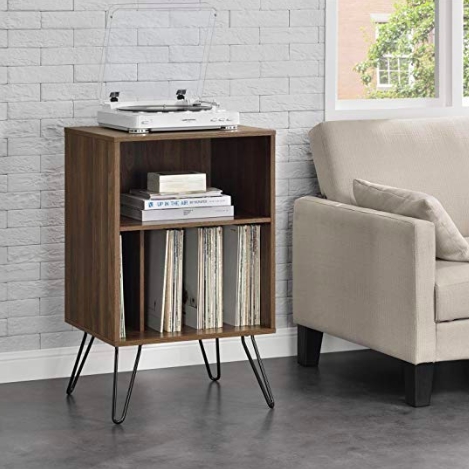
The last item on my list is a good box, crate or shelf to store vinyl records.
Records that are stored incorrectly can get warped (bent) and destroyed.
I have a whole article on this subject, but the key lessons are:
- Store records standing upright
- Don’t store records in direct sunlight
- Store records reasonably cold and dry
If you have a suitable bookshelf or an old wine case, you are good.
If you need to invest in storage, good choices are the Ikea Kallax shelf, the Novogratz Concord Turntable Stand or a Chalkboard Vinyl Record Storage Crate.
Conclusion
The list above covers everything you need to enjoy vinyl.
When you can tick off the 7 items on the list above the next logical (and very optional) item to consider spending money on will in most cases be a cartridge upgrade that can have a huge positive impact on the turntable’s sonic performance. If interested, you can read my article on the subject by clicking here.
But the most important step from here is to enjoy good sounding records and to keep them in mint collection as time goes by.
Related questions
What is a record slipmat?
A record slipmat is a piece of felt material that sits between the record and the turntable platter. It was originally invented by DJs to help the record slip on the platter when scratching. On turntables that is used for music listening rather that scratching, a turntable rubber mat is often preferred over of a felt slipmat. As a rubber mat provides more dampening and stability.
What is a record clamp?
A record clamp or weight is a device that is placed on top of the record on the turntable to stabilize the speed of the record and/or to level out warped records. A record clamp is generally considered to have a marginal impact on sound quality, but will in many cases help to level out warped records.
Why Do i need a preamp for my turntable?
I preamp is necessary because the cartridge that sits on the tip of the turntable tonearm outputs a signal that is PHONO level. A PHONO level signal is very tiny and need to be boosted about 1000 times before it has the same signal level as other music sources like CD players, digital streamers, etc. The PHONO signal also needs to be tone corrected. These two tasks are done by the preamp. Also called phono stage. The preamp can be a standalone box or built into the turntable or receiver. And even built into active speakers.

